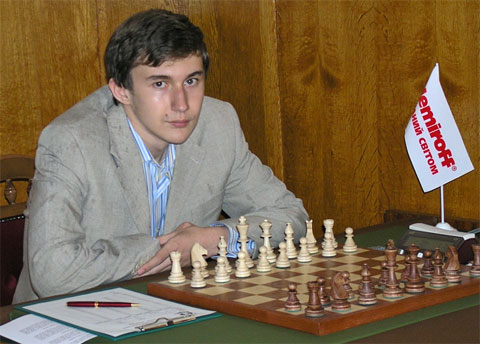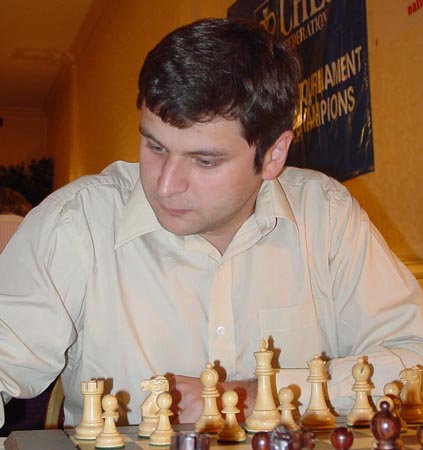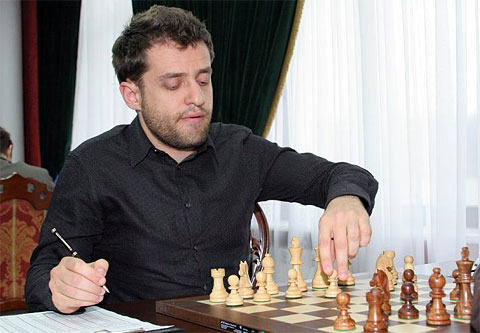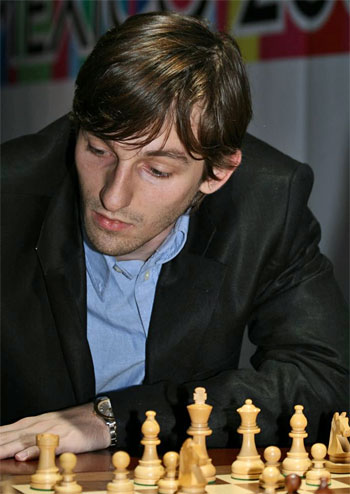| Latest | Greatest | Lobby | Journals | Search | Options | Help | Login |
|
|
|
This topic is archived. |
| Home » Discuss » Topic Forums » Sports |
|
| Jack Rabbit
|
Sat Apr-18-09 12:05 AM Original message |
| The JR Chess Report (April 17): Nalchik Grand Prix in Progress |
|
Tomsk, Spartak Vidnoe and Polytechnik win Russian Team Championships
 The fourth leg of the 2008-09 FIDE Grand Prix opened Wednesday in Nalchik, Kabardino-Balkaria (Russia) with 14 players participating. The competitors are: Vladimir Akopian (Armenia); Evgeny Alekseev (Russia); Levon Aronian (Armenia); Etienne Bacrot (France); Pavel Eljanov (Ukraine); Boris Gelfand (Israel); Alexander Grischuk (Russia); Vassily Ivanchuk (Ukraine); Gata Kamsky (United States); Sergey Karjakin (Ukraine); Rustam Kasimdzhanov (Uzbekistan); Peter Leko (Hungary); Shakhriyar Mamedyarov (Azerbaijan); and Peter Svidler (Russia). After three rounds, Grischuk leads with 2� points, with Alekseev, Aronian, Leko and Svidler tied for second with 2 points each. The fourth round will be played Saturday starting about 4 am PDT. The games will be carried live on ChessBase.com. The event concludes April 29. Karjakin to become Russian  Sergey Karjakin Alexander Karjakin, father of 19-year-old Ukrainian grandmaster Sergey Karjakin, announced this week that the family is moving to Moscow, applying for Russian citizenship and that his son will henceforth play under the Russian flag. Although this sounds drastic, the move is strictly financial. The Ukrainian chess federation is strapped for cash and cannot afford to give out the monetary rewards or to provide other support to its top players that the Russian federation can. In addition to getting more monetary support from the Russian federation for achievements like playing on the Russian olympic team, Karjakin will be trained by Russian GM Yuri Dohoyan, who once served as second to former world champion Garry Kasparov. Karjakin's move is met by understanding and support from his Ukrainian peers. Calendar Dubai Open 25 April-5 May. MTel Masters, Sofia 9-19 May. Asian Championships, Subic Freeprot (The Philippines) 12-23 May. US Chess Championship, St. Louis 18-29 May. Chicago Open 22-25 May. Aerosvit International Tournament, Foros (Ukraine) 9-20 June. World Open, Philadelphia 29 June-5 July. San Sebastian International Tournament 6-16 July. Former world champion Karpov is among the participants. Canadian Open, Edmonton 11-19 July. Czech Open, Pardubice 16 July-2 August. Biel Chess Festival 18-31 July. FIDE Grand Prix, Yerevan. 8-24 August. |
| Printer Friendly | Permalink | | Top |
| Jack Rabbit
|
Sat Apr-18-09 12:06 AM Response to Original message |
| 1. This week's games |
|
To be posted over the next several hours.
Your humble hare acknowledges the assistance of Fritz 6.0 on analysis. Diagrams on the Jack Rabbit Chess Report are made with Chess M�rida, a true type font that can be downlaoded free here. !""""""""# $tMvWlVmT% $OoOoOoOo% $ + + + +% $+ + + + % $ + + + +% $+ + + + % $pPpPpPpP% $RnBqKbNr% /(((((((() WHITE White to move (This position is a theoretical draw) |
| Printer Friendly | Permalink | | Top |
| Jack Rabbit
|
Sat Apr-18-09 12:08 AM Response to Reply #1 |
| 2. Russian Team Championships, Sochi |
| Printer Friendly | Permalink | | Top |
| Jack Rabbit
|
Sat Apr-18-09 12:10 AM Response to Reply #2 |
| 3. Levin - Timofeev, Premiere League, Round 2 |
 Artyom Timofeev Evgeny Levin (Chigorin St. Petersburg) - Artyom Timofeev (Tomsk) Russian Team Championships, Premier League, Round 2 Sochi, 5 April 2009 Semi-Slav Queen's Gambit: Stoltz Opening 1.d4 d5 2.c4 e6 3.Nc3 c6 4.e3 Nf6 5.Nf3 Nbd7 6.Qc2 Bd6 7.b3
7...0-0 8.Be2 Qe7
9.0-0 dxc4
10.bxc4 e5 11.a4
11...Re8 12.a5!?
12...exd4
13.exd4
13...Nf8 14.Re1 Bg4 15.Be3 Ne6 16.g3!?
16...Bb4!
17.Red1
17...c5 18.Nb5?
!""""""""# $t+ +t+l+% $Oo+ WoOo% $ + +mM +% $PnO + + % $ VpP +v+% $+ + BnP % $ +q+bP P% $R +r+ K % /(((((((() WHITE: Evgeny Levin Position after 18.Nc3b5 18...cxd4!
19.Nfxd4
19...Nxd4 20.Nxd4 Qe5 21.Rab1
21...Bc5?
22.Rb5!
22...b6 23.axb6 axb6 24.Re1?!
24...Bd7!
25.Nf3 Qc7 26.Bf4 Qb7
27.Rb2?
!""""""""# $t+ +t+l+% $+w+v+oOo% $ O + M +% $+rV + + % $ +p+ B +% $+ + +nP % $ +q+bP P% $+ + R K % /(((((((() WHITE: Evgeny Levin Position after 27.Rb5b2 27...Qxf3!!
28.Bxf3 Rxe1+ 29.Kg2 Raa1!
30.h3 Rh1 31.Bg4 Bc6+ 0-1
|
| Printer Friendly | Permalink | | Top |
| Jack Rabbit
|
Sat Apr-18-09 12:11 AM Response to Reply #2 |
| 4. Ivkina - Lahno, Women's League, Round 3 |
 Katya Lahno Olga Ivkina (Chigorin St. Petersburg) - Katya Lahno (Spartak Vidnoe) Russian Team Championships, Woemn's League, Round 3 Sochi, 4 April 2009 Spanish Petit Royal Game: Calabrian Defense (Schliemann Defense) 1.e4 e5 2.Nf3 Nc6 3.Bb5 f5 4.d4
4...fxe4 5.Bxc6
5...dxc6 6.Nxe5 Nf6
7.Bg5
7...c5
8.c3 Be7!?
9.0-0
9...Be6 10.Qe2 0-0
11.Bxf6 gxf6!?
12.Nd3 f5
13.Nxc5 Bxc5 14.dxc5 Qd5 15.Nd2 Qxc5 16.Nb3
16...Qc4 17.Qh5 Rae8
18.Rfd1 b6 19.Rd4 Qc6 20.Rad1 Bc8
21.Qg5+ Qg6
22.Qf4 Qg7 23.R4d2 Qe5 24.Qg5+
24...Qg7 25.Qf4 c5
26.Rd6 Be6 27.Nc1 Kh8 28.Ne2!?
!""""""""# $ + +tT L% $O + + Wo% $ O Rv+ +% $+ O +o+ % $ + +oQ +% $+ P + + % $pP +nPpP% $+ +r+ K % /(((((((() WHITE: Olga Ivkina Position after 28.Nc1e2 28...Bxa2!
29.Rd7 Re7 30.Qc7 Rfe8 31.Nf4 Bg8 32.h4 Qf6 33.h5
33...e3 34.fxe3 Rxe3 35.Rd8
35...Re1+ 36.Rxe1?!
36...Rxe1+ 37.Kh2 Qh4+ 38.Nh3 !""""""""# $ + R +vL% $O Q + +o% $ O + + +% $+ O +o+p% $ + + + W% $+ P + +n% $ P + +pK% $+ + T + % /(((((((() WHITE: Olga Ivkina Position after 38.Nf4h3 38...f4!
39.Rd3 Qxh5 40.Qxf4 Qe5
41.Rd7 Qxf4+ 42.Nxf4
42...Rb1 43.Nd3
43...Rd1?!
44.Nxc5! Rxd7 45.Nxd7
45...Kg7 46.Kg3 Bd5 47.b4?
47...Be6 48.Ne5 !""""""""# $ + + + +% $O + + Lo% $ O +v+ +% $+ + N + % $ P + + +% $+ P + K % $ + + +p+% $+ + + + % /(((((((() WHITE: Olga Ivkina Position after 48.Nd7e5 48...a5!
49.bxa5 bxa5 50.Nc6
50...a4 51.Nd4 Kf6 52.Kf4
52...a3! 53.Nc2 a2 54.g3
54...Bf5 55.Na1 Ke6 56.Nb3 Bg6 57.c4
57...Bd3 58.Na1
58...Bxc4 59.Ke4 Kf6 60.Kf4
60...Be6 61.Nc2 Bb3 62.Na1 Bd1 63.Ke3 Kg5 64.Kd2
64...Bf3 65.Ke3 Kg4 66.Kf2 h5!
67.Nc2 Bd1 68.Na1 Kh3 69.Ke1 !""""""""# $ + + + +% $+ + + + % $ + + + +% $+ + + +o% $ + + + +% $+ + + Pl% $o+ + + +% $N +vbK + % /(((((((() WHITE: Olga Ivkina Position after 69.Kf2e1 69...Kxg3!!
70.Kxd1 h4 0-1
|
| Printer Friendly | Permalink | | Top |
| Jack Rabbit
|
Sat Apr-18-09 12:12 AM Response to Reply #2 |
| 5. A. Muzychuk - Zdebskaja, Women's League, Round 5 |
 Anna Muzychuk Natalia Zdebskaja (PetroDom St. Petersburg) - Anna Muzychuk (AVS Krasnoturyinsk) Russian Team Championships, Woemn's League. Round 5 Sochi, 7 April 2009 Spanish Grand Royal Game: Chigorin Defense (Neo-Marshall Gambit) 1.e4 e5 2.Nf3 Nc6 3.Bb5 a6 4.Ba4 Nf6 5.0-0 Be7 6.Re1 b5 7.Bb3 d6 8.c3 0-0 9.h3 Na5 10.Bc2 d5!?
!""""""""# $t+vW Tl+% $+ O VoOo% $o+ + M +% $Mo+oO + % $ + +p+ +% $+ P +n+p% $pPbP Pp+% $RnBqR + % /(((((((() WHITE: Natalia Zdebskaja Position after 10...d5 11.d4
11...dxe4
12.Nxe5 c5
13.Be3
13...Qc7
14.Nd2 Bb7 15.Qb1
15...cxd4 16.Bxd4 Bd6
17.Ng4 Nxg4 18.hxg4 Bh2+
19.Kh1 Bf4
20.Nxe4 Rfe8
21.g5 Nc6 22.Be3 Bxe3
23.Rxe3 Ne5 24.Qd1 Nc4 25.Re1!?
25...Bxe4!?
26.Bxe4 Rad8 27.Qg4?
27...Nxb2 28.Re3
!""""""""# $ + Tt+l+% $+ W +oOo% $o+ + + +% $+o+ + P % $ + +b+q+% $+ P R + % $pM + Pp+% $R + + +k% /(((((((() WHITE: Natalia Zdebskaja Position after 28.Re1e3 28...g6!
29.Rae1 Nc4 30.Rh3
30...Nd2 31.Qh4 h5 32.f3
32...Qc4 33.a3
33...Re6 34.Rd1 Qb3 35.Re1
!""""""""# $ + T +l+% $+ + +o+ % $o+ +t+o+% $+o+ + Po% $ + +b+ Q% $PwP +p+r% $ + M +p+% $+ + R +k% /(((((((() WHITE: Natalia Zdebskaja Position after 35.Rd1e1 35...Rde8!
36.Re3 Qxa3 37.Qe1 Rd8
38.Kh2 Qd6+
39.Kh1 Qf4 40.g4
40...Nxe4 41.fxe4 Qxg4 42.Rhg3
42...Qh4+ 43.Kg1 Red6 0-1
|
| Printer Friendly | Permalink | | Top |
| Jack Rabbit
|
Sat Apr-18-09 12:49 AM Response to Reply #1 |
| 6. Foxwoods Open, Mashantucket, Connecticut |
| Printer Friendly | Permalink | | Top |
| Jack Rabbit
|
Sat Apr-18-09 12:51 AM Response to Reply #6 |
| 7. Sadvakasov - Hess, Round 8 |
|
Grandmaster Darmen Sadvakasov of Kazakhstan won the Foxwoods Open by drawing an Armageddon game with Black in a blitz playoff with Yury Shulman. Shulman had been leading the tournament since defeating Sadvakasov in round 4. To force the playoff, Sadvakasov had to score 4� points in the last five rounds.
Well done.  Darmen Sadvakosov Darmen Sadvakasov - Robert Hess Foxwoods Open, Round 8 Mashantucket, 12 April 2009 Spanish Grand Royal Game: Rat Defense (Neo-Steinitz Defense) 1.e4 e5 2.Nf3 Nc6 3.Bb5 a6 4.Ba4 d6
5.c3
5...Bd7 6.d4 Nge7
7.Bb3
7...h6 8.a4
8...Ng8!?
9.Nbd2
9...Nf6 10.0-0 Be7 11.Re1 Bg4 12.h3 Bh5 !""""""""# $t+ Wl+ T% $+oO VoO % $o+nO + O% $+ + O +v% $p+ Pp+ +% $+bP +n+p% $ P + Pp+% $R BqR K % /(((((((() WHITE: Darmen Sadvakasov Position after 12...Bg4h5 13.d5!
13...Nb8
14.Nf1 c6
15.Ng3!
15...Bg6
16.Nh4 Bh7 17.Nhf5 0-0 18.a5 Qd7
19.Bc2
19...Bd8
20.c4 b5 21.axb6 Bxb6 22.Qf3
22...Qd8 23.Bd2 cxd5
24.cxd5 Nbd7 25.Ba4 Nc5 26.Bc6 Ra7
27.b4 Ne6 28.dxe6!
28...fxe6 29.Qb3 d5 30.Ne3
30...Nxe4
31.Nxe4 Bxe4 32.Ng4 h5 !""""""""# $ + W Tl+% $T + + O % $oVb+o+ +% $+ + O +o% $ P +o+n+% $+q+ + +p% $ + B Pp+% $R + + K % /(((((((() WHITE: Darmen Sadvakasov Position after 32...h6h5 33.Rxe4!!
33...dxe4 34.Qxe6+ Raf7 35.Nxe5 Qxd2
36.Be8!
36...Qxf2+!
37.Kh1 Bd4
38.Bxf7+!
38...Rxf7 39.Nxf7 Qxf7
40.Qxf7+ Kxf7 41.Rxa6
41...e3!
42.Ra2 Ke6?
!""""""""# $ + + + +% $+ + + O % $ + +l+ +% $+ + + +o% $ P V + +% $+ + O +p% $r+ + +p+% $+ + + +k% /(((((((() WHITE: Darmen Sadvakasov Position after 42...Kf7e6 43.g3!
43...Kd5 44.Kg2 Kc4 45.Kf3 Kxb4 46.Ra6!
46...Kc4 47.Ke2 Be5 48.Rg6 Kd4 49.Rg5 Ke4 !""""""""# $ + + + +% $+ + + O % $ + + + +% $+ + V Ro% $ + +l+ +% $+ + O Pp% $ + +k+ +% $+ + + + % /(((((((() WHITE: Darmen Sadvakasov Position after 49...Kd4e4 50.h4! 1-0
|
| Printer Friendly | Permalink | | Top |
| Jack Rabbit
|
Sat Apr-18-09 12:53 AM Response to Reply #6 |
| 8. Shulman - van Wely, Round 5 |
|
Reigning US champion Yury Shulman and former champion Alex Onischuk have done American chess proud so far in 2009 with their performances in international open competitions.
Here, Shulman dispatches former six-time Dutch national champion Loek van Wely, who also played good chess overall at the Foxwoods.  Yury Shulman Yury Shulman - Loek van Wely Foxwoods Open, Round 5 Mashantucket, 10 April 2009 Semi-Slav Queen's Gambit, Anti-Meran Gambit (Moscow Defense) 1.d4 d5 2.c4 c6 3.Nf3 Nf6 4.Nc3 e6 5.Bg5 h6 6.Bh4 dxc4 7.e4 g5 8.Bg3 b5
9.Ne5
9...Bb7 10.h4
10...g4 11.Nxg4
11...Nxg4
12.Qxg4 Qxd4 13.Rd1 Qf6
14.e5
14...Qf5 15.Qd4 Be7 16.a4!?
16...Kf8!?
17.f3?!
17...Na6?!
18.axb5! cxb5 19.Nxb5 Nb4 20.Qf4!?
20...Qxf4 21.Bxf4 Bd5!?
!""""""""# $t+ + L T% $O + Vo+ % $ + +o+ O% $+n+vP + % $ Mo+ B P% $+ + +p+ % $ P + +p+% $+ +rKb+r% /(((((((() WHITE: Yury Shulman Position after 21...Bb7d5 22.Nd6!
22...Nd3+?
23.Bxd3 cxd3 24.Rxd3 Rb8 25.0-0!?
25...Bxh4 26.Be3 Rxb2 27.Rc1 Bg3
!""""""""# $ + + K T% $O + +o+ % $ + No+ O% $+ +vP + % $ + + + +% $+ +rBpV % $ T + +p+% $+ R + K % /(((((((() WHITE: Yury Shulman Position after 27...Bh4g3 28.Rxd5!!
28...exd5 29.Nf5!
29...Ke8 30.Nxg3 Kd7 31.Bd4 Rbb8 32.Ra1 1-0
|
| Printer Friendly | Permalink | | Top |
| Jack Rabbit
|
Sat Apr-18-09 12:54 AM Response to Reply #6 |
| 9. Nakamura - Hess, Round 5 |
|
Robert Hess, a New York high school student and athlete, earned his third and final needed grandmaster norm in Mashantucket. His Elo rating is already over the required 2500 and he will be named a grandmaster later this year.
Congratulations, young man.  Robert Hess Hikaru Nakamura - Robert Hess Foxwoods Open, Round 5 Mashantucket, 10 April 2009 Symmetrical English Game: Mikenas-Carls Opening (Nei Gambit) 1.c4 Nf6 2.Nc3 e6 3.e4 c5
4.e5 Ng8 5.Nf3 Nc6 6.d4 cxd4 7.Nxd4 Nxe5
8.Ndb5 f6 9.Bf4
9...a6 10.Nd6+
10...Bxd6 11.Qxd6 Nf7 12.Qa3 Ne7 13.Nb5!?
13...e5
14.Bd2 d6
15.Bb4 Nf5 16.0-0-0
16...Be6
17.Nxd6+
17...N7xd6 18.Bxd6 Nxd6 19.Rxd6 Qe7
20.Be2
20...Rc8
21.b3
21...Kf7 22.Kb2 Rhd8 23.Rhd1 Rxd6
24.Rxd6 Rd8 25.c5 a5 26.Bh5+?
!""""""""# $ + T + +% $+o+ WlOo% $ + RvO +% $O P O +b% $ + + + +% $Qp+ + + % $pK + PpP% $+ + + + % /(((((((() WHITE: Hikaru Nakamura Position after 26.Be2h5+ 26...g6!
27.Bf3 Qc7 28.Rxd8 Qxd8 29.Kc1
29...Bf5 30.b4
30...Qd4 31.bxa5 Qxf2 32.Qb3+ Kg7
33.Qxb7+ Kh6 34.Qb2
!""""""""# $ + + + +% $+ + + +o% $ + + OoL% $P P O + % $ + + + +% $+ + +b+ % $pQ + WpP% $+ K + + % /(((((((() WHITE: Hikaru Nakamura Position after 34.Qd4b2 34...Qxc5+!
35.Kd1 e4 36.Be2
36...e3 37.Ke1
37...Qxa5+ 38.Kf1 Qc7
39.Qd4 Qc1+ 40.Qd1
40...Qb2 41.a4 Qb4 42.Kg1
42...Bd7 43.Qa1
!""""""""# $ + + + +% $+ +v+ +o% $ + + OoL% $+ + + + % $pW + + +% $+ + O + % $ + +b+pP% $Q + + K % /(((((((() WHITE: Hikaru Nakamura Position after 43.Qd1a1 43...Qf4!
44.Qf1 Qxf1+ 45.Kxf1 Bxa4 46.Bd3 Bd1 47.Be2
47...Bc2 48.Bb5 f5 49.g3 g5 0-1
|
| Printer Friendly | Permalink | | Top |
| Jack Rabbit
|
Sat Apr-18-09 01:46 AM Response to Reply #1 |
| 10. FIDE Grand Prix, Nalchik |
| Printer Friendly | Permalink | | Top |
| Jack Rabbit
|
Sat Apr-18-09 01:50 AM Response to Reply #10 |
| 11. Mamedyarov - Aronian, Round 1 |
 Levon Aronian Shakhriyar Mamedyarov - Levon Aronian FIDE Grand Prix, Round 1 Nakchik, 15 April 2009 Vienna Game: Italian Opening (Gothic Defense) 1.e4 e5 2.Nc3 Nc6
3.Bc4 Nf6 4.d3 Na5
5.Nge2 Be7
6.0-0 0-0 7.a4
7...Nxc4 8.dxc4 d6 9.b3 Be6 10.a5!?
10...c6
11.a6!?
11...b6
12.Ba3
12...Qc7 13.f4?!
!""""""""# $t+ + Tl+% $O W VoOo% $pOoOvM +% $+ + O + % $ +p+pP +% $BpN + + % $ +p+n+pP% $R +q+rK % /(((((((() WHITE: Shakhriyar Mamedyarov Position after 13.f2f4 13...Rad8!
14.Kh1 Bc8
15.Bb2 Ng4 16.Qd3
16...exf4 17.Nxf4 Bh4 18.Qe2
18...Rfe8 19.h3 Ne5
20.Nd1?!
20...Bg5 21.Nh5
21...Qe7?!
22.Ne3 g6
23.Nf4?
23...Nd7 24.Nh5
!""""""""# $ + + + +% $O +mWo+o% $pOoO +o+% $+ + + Vn% $ +p+p+ +% $+p+ N +p% $ Bp+q+p+% $R + +r+k% /(((((((() WHITE: Shakhriyar Mamedyarov Position after 24.Nf4h5 24...Qxe4!
25.Qf2 f5 26.Ng4
26...gxh5 27.Nh6+
27...Bxh6 28.Qg3+ Kf7 29.Rae1 Rg8!
30.Qf2
!""""""""# $ +vT +t+% $O +m+l+o% $pOoO + V% $+ + +o+o% $ +p+w+ +% $+p+ + +p% $ Bp+ Qp+% $+ + Rr+k% /(((((((() WHITE: Shakhriyar Mamedyarov Position after 30.Qg3f2 30...Qxg2+!!
31.Qxg2 Rxg2 32.Kxg2 0-1
|
| Printer Friendly | Permalink | | Top |
| Jack Rabbit
|
Sat Apr-18-09 01:54 AM Response to Reply #10 |
| 12. Svidler - Ivanchuk, Round 2 |
 Peter Svidler Peter Svidler - Vassily Ivanchuk FIDE Grand Prix, Round 2 Nakchik, 16 April 2009 Spanish Grand Royal Game: Kasparov Opening 1.e4 e5 2.Nf3 Nc6 3.Bb5 a6 4.Ba4 Nf6 5.0-0 b5 6.Bb3 Bb7 7.d3 Be7 8.a4 0-0 9.Re1 d6 10.Nbd2 Re8 11.Nf1 h6
12.Ne3
12...Bf8 13.g4!?
13...Nd4
14.Nxd4 exd4 15.Nf5 !""""""""# $t+ WtVk+% $+vO +oO % $o+ O M O% $+O+ +n+ % $p+ Op+p+% $+b+p+ + % $ Pp+ P P% $R BqR K % /(((((((() WHITE: Peter Svidler Position after 15.Nd3f5 15...d5!
16.axb5
16...dxe4
17.dxe4 axb5 18.Rxa8 Qxa8
19.e5 Ne4?!
20.e6
20...fxe6 21.Nxd4
21...Rd8 22.Bxe6+
22...Kh8 23.g5 Rxd4!?
24.Qxd4 Bc5 25.Qe5 Bxf2+?
26.Kf1
26...Qf8
!""""""""# $ + + W K% $+vO + O % $ + +b+ O% $+o+ Q + % $ + +m+ +% $+ + + + % $ Pp+ V P% $+ B Rk+ % /(((((((() WHITE: Peter Svidler Position after 26...Qa8f8 27.gxh6!!
27...Bxe1+
28.Bf4 Nd2+ 29.Ke2! 1-0
|
| Printer Friendly | Permalink | | Top |
| Jack Rabbit
|
Sun Apr-19-09 01:15 AM Response to Reply #10 |
| 13. Grischuk - Gelfand, Round 1 |
|
Edited on Sun Apr-19-09 01:21 AM by Jack Rabbit
 Alexander Grischuk Alexander Grischuk - Boris Gelfand FIDE Grand Prix, Round 1 Nakchik, 15 April 2009 Grand Orthodox Queen's Gambit: Tartakover Defense 1.d4 Nf6 2.c4 e6 3.Nf3 d5 4.Nc3 Be7 5.Bg5
5...h6
6.Bh4 0-0 7.e3 b6
8.Be2
8...Bb7 9.Bxf6 Bxf6 10.cxd5 exd5 11.b4
11...c5
12.bxc5 bxc5 13.Rb1 Bc6
14.0-0 Nd7 15.Bb5 Qc7 16.Qd3
16...Rfc8 17.Rfd1
17...Rab8 18.a4 cxd4 19.exd4!?
19...Ba8!?
!""""""""# $vTt+ +l+% $O Wm+oO % $ + + V O% $+b+o+ + % $p+ P + +% $+ Nq+n+ % $ + + PpP% $+r+r+ K % /(((((((() WHITE: Alexander Grischuk Position after 19...Bc6a8 20.Qf5!
20...Qxc3
21.Qxd7
21...Qc7 22.Qf5 Rb6?!
23.Ne5 g6
24.Qf4 Bg5 25.Qg4 a6?!
26.h4 Bf6 27.Bd3 Rxb1 28.Rxb1 h5
!""""""""# $v+t+ +l+% $+ W +o+ % $o+ + Vo+% $+ +oN +o% $p+ P +qP% $+ +v+ + % $ + + Pp+% $+r+ + K % /(((((((() WHITE: Alexander Grischuk Position after 28...h6h5 29.Qf4!
29...Bxe5?!
30.dxe5 Re8 31.Rc1
31...Qd7?
32.Bxa6 d4 33.Bc4
33...Qf5
!""""""""# $v+ +t+l+% $+ + +o+ % $ + + +o+% $+ + Pw+o% $p+bO Q P% $+ + + + % $ + + Pp+% $+ R + K % /(((((((() WHITE: Alexander Grischuk Position after 33...Qd7f5 34.Qxf5
34...gxf5
35.Rd1 Rxe5 36.Rxd4 Bc6 37.Bb3 Re1+
38.Kh2 Rb1 39.Bd5 Bxd5 40.Rxd5 Rb4 41.g3 f4
42.a5 fxg3+ 43.fxg3 Ra4 44.Rxh5 Kg7
45.Rf5 Kg6 46.g4 f6
47.h5+ Kg7 48.g5 fxg5 49.Rxg5+ Kf6 50.Rb5 1-0
|
| Printer Friendly | Permalink | | Top |
| Jack Rabbit
|
Sun Apr-19-09 01:34 PM Response to Original message |
| 14. Update (Sunday): Grischuk leads Nalchik at first break |
|
Edited on Sun Apr-19-09 01:35 PM by Jack Rabbit
 Russian grandmaster Alexander Grischuk, who won the international tournament at Linares last month, is leading the fourth leg of the FIDE Grand Prix in Nalchik, Kabardino-Balkaria (Russia) after five rounds going into the first of two scheduled rest days tomorrow. Grischuk, with 3� points, is a half point ahead of Sergey Karjakin, who is still Ukrainian but will be Russian before long, Hungary's Peter Leko, former Russian national champion Evgeny Alekseev and Levon Aronian of Armenia, who are in a tie for second at 3 points each. Grischuk, playing White, drew his game today against Leko. In other action today, GM Rustam Kasimdzhanov of Uzbekistan, playing Black, defeated Ukrainian GM Vassily Ivanchuk in 25 moves and Armenia's Vladimir Akopian beat Gata Kamsky of the United States in 98 moves. All other games were drawn. The action resumes with round 6 on Tuedaay, when Grischuk will have White against Shakhriyar Mamedyaov of Azerbaijan. |
| Printer Friendly | Permalink | | Top |
| Jack Rabbit
|
Tue Apr-21-09 10:47 PM Response to Original message |
| 15. Update (Tuesday): Tehran wins Asian Cities Team Tournament |
|
Edited on Tue Apr-21-09 10:48 PM by Jack Rabbit
 A powerhouse team representing the the Iranian capital city Tehran has won the 16th Asian Cities Team Championship today in Beirut, Lebanon with one round still remaining. The Tehran team, lead by Iran's top ranked player, Eshan Ghaem Maghami, boasts three grandmasters, where most of the other 19 teams in the event have none. So far, Tehran has won seven matches and drawn one. In today's tournament clinching eighth round, Tehran underscored its superiority by defeating Aleppo 4-0. The surprise of the event has been another Iranian team, this one from Bandar Emam and compised of women. The team won three of their first four matches, disposing of second seed Baghdad in the first round behind a victory by Ghaem Maghami's wife, Shayesteh Ghaderpour in the match's only decisive game. We should offer congratulations to the Iranian women's coach, British GM Nigel Short, on his good work in persuading Iranian authorities to invest in promoting the women's team. |
| Printer Friendly | Permalink | | Top |
| DU
AdBot (1000+ posts) |
Thu Apr 25th 2024, 04:28 AM Response to Original message |
| Advertisements [?] |
| Top |
| Home » Discuss » Topic Forums » Sports |
|
Powered by DCForum+ Version 1.1 Copyright 1997-2002 DCScripts.com
Software has been extensively modified by the DU administrators
Important Notices: By participating on this discussion board, visitors agree to abide by the rules outlined on our Rules page. Messages posted on the Democratic Underground Discussion Forums are the opinions of the individuals who post them, and do not necessarily represent the opinions of Democratic Underground, LLC.
Home | Discussion Forums | Journals | Store | Donate
About DU | Contact Us | Privacy Policy
Got a message for Democratic Underground? Click here to send us a message.
© 2001 - 2011 Democratic Underground, LLC